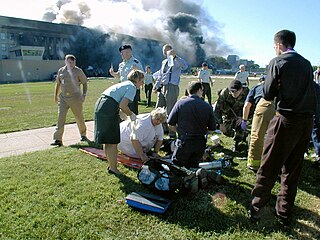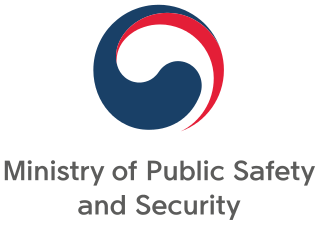
Civil defense or civil protection is an effort to protect the citizens of a state from human-made and natural disasters. It uses the principles of emergency operations: prevention, mitigation, preparation, response, or emergency evacuation and recovery. Programs of this sort were initially discussed at least as early as the 1920s and were implemented in some countries during the 1930s as the threat of war and aerial bombardment grew. Civil-defense structures became widespread after authorities recognised the threats posed by nuclear weapons.
Homeland security is an American national security term for "the national effort to ensure a homeland that is safe, secure, and resilient against terrorism and other hazards where American interests, aspirations, and ways of life can thrive" to the "national effort to prevent terrorist attacks within the United States, reduce the vulnerability of the U.S. to terrorism, and minimize the damage from attacks that do occur." According to an official work published by the Congressional Research Service in 2013, the "Homeland security" term's definition has varied over time.

Federal Emergency Management Agency (FEMA) is an agency of the United States Department of Homeland Security (DHS), initially created under President Jimmy Carter by Presidential Reorganization Plan No. 3 of 1978 and implemented by two Executive Orders on April 1, 1979. The agency's primary purpose is to coordinate the response to a disaster that has occurred in the United States and that overwhelms the resources of local and state authorities. The governor of the state in which the disaster occurs must declare a state of emergency and formally request from the President that FEMA and the federal government respond to the disaster. The only exception to the state's gubernatorial declaration requirement occurs when an emergency or disaster takes place on federal property or to a federal asset—for example, the 1995 bombing of the Alfred P. Murrah Federal Building in Oklahoma City, Oklahoma, or the Space Shuttle Columbia in the 2003 return-flight disaster.
In the United States, an interstate compact is a pact or agreement between two or more states, or between states and any foreign government. The Compact Clause of the United States Constitution provides that "No State shall, without the Consent of Congress,... enter into any Agreement or Compact with another State, or with a foreign Power,..."

The Compacts of Free Association (COFA) are international agreements establishing and governing the relationships of free association between the United States and the three Pacific Island sovereign states of the Federated States of Micronesia (FSM), the Republic of the Marshall Islands (RMI), and the Republic of Palau. As a result, these countries are sometimes known as the Freely Associated States (FAS's). All three agreements next expire in 2043.
An office of emergency management (OEM), alternatively called an emergency management office (EMO), or an emergency management agency (EMA) in some areas, is an agency at the local, tribal, state, federal, or international level that holds responsibility for comprehensively planning for and responding to and recovering from all manner of disasters, whether man-made or natural. An OEM may also be requested to provide consequence management for large special events such as major gatherings, visiting dignitaries, damage assessment following a disaster, etc.

Emergency management or disaster management is a science and a system charged with creating the framework within which communities reduce vulnerability to hazards and cope with disasters. Emergency management, despite its name, does not actually focus on the management of emergencies, which can be understood as minor events with limited impacts and are managed through the day-to-day functions of a community. Instead, emergency management focuses on the management of disasters, which are events that produce more impacts than a community can handle on its own. The management of disasters tends to require some combination of activity from individuals and households, organizations, local, and/or higher levels of government. Although many different terminologies exist globally, the activities of emergency management can be generally categorized into preparedness, response, mitigation, and recovery, although other terms such as disaster risk reduction and prevention are also common. The outcome of emergency management is to prevent disasters and where this is not possible, to reduce their harmful impacts.

The Ministry of the Russian Federation for Civil Defence, Emergency Situations and Elimination of Consequences of Natural Disasters, also known as the Ministry of Emergency Situations or internationally as EMERCOM, is a Russian government agency overseeing the civil emergency services in Russia.

The United States Northern Command (USNORTHCOM) is one of eleven unified combatant commands of the United States Department of Defense. The command is tasked with providing military support for non-military authorities in the U.S., and protecting the territory and national interests of the United States within the continental United States, Puerto Rico, Canada, Mexico, The Bahamas, and the air, land and sea approaches to these areas. It is the U.S. military command which, if applicable, would be the primary defender against an invasion of the U.S.

The Robert T. Stafford Disaster Relief and Emergency Assistance Act is a 1988 United States federal law designed to bring an orderly and systematic means of federal natural disaster assistance for state and local governments in carrying out their responsibilities to aid citizens. Congress's intention was to encourage states and localities to develop comprehensive disaster preparedness plans, prepare for better intergovernmental coordination in the face of a disaster, encourage the use of insurance coverage, and provide federal assistance programs for losses due to a disaster.
The Florida Division of Emergency Management (DEM) is charged with maintaining a comprehensive statewide program of emergency management. The division ensures that Florida is prepared to respond to emergencies, recover from them, and mitigate their impacts. DEM is responsible for the State Emergency Response Team (SERT) which is composed of various intergovernmental entities, volunteers, and the private sector. The division coordinates the efforts of the Federal Government with other departments and agencies of state government, with county and municipal governments and school boards, and with private agencies that have a role in emergency management. The Director is appointed by the Governor of Florida, and serves as an agency head. Kevin Guthrie currently serves as the Director. He was appointed by Governor Ron DeSantis in May 2021.

The Nevada Air National Guard is the aerial militia of the State of Nevada, United States of America. Along with the Nevada Army National Guard, it is an element of the Nevada National Guard. The units of the Nevada Air National Guard are not in the normal United States Air Force chain of command. They are under the jurisdiction of the Governor of Nevada through the office of the Nevada Adjutant General unless it is federalized by order of the President of the United States.
In emergency services, mutual aid is an agreement among emergency responders to lend assistance across jurisdictional boundaries. This may occur due to an emergency response that exceeds local resources, such as a disaster or a multiple-alarm fire. Mutual aid may be ad hoc, requested only when such an emergency occurs. It may also be a formal standing agreement for cooperative emergency management on a continuing basis, such as ensuring that resources are dispatched from the nearest fire station, regardless of which side of the jurisdictional boundary the incident is on. Agreements that send closest resources are regularly referred to as "automatic aid agreements".

Disaster medicine is the area of medical specialization serving the dual areas of providing health care to disaster survivors and providing medically related disaster preparation, disaster planning, disaster response and disaster recovery leadership throughout the disaster life cycle. Disaster medicine specialists provide insight, guidance and expertise on the principles and practice of medicine both in the disaster impact area and healthcare evacuation receiving facilities to emergency management professionals, hospitals, healthcare facilities, communities and governments. The disaster medicine specialist is the liaison between and partner to the medical contingency planner, the emergency management professional, the incident command system, government and policy makers.

The Administration for Strategic Preparedness and Response (ASPR) is an operating agency of the U.S. Public Health Service within the Department of Health and Human Services that focuses preventing, preparing for, and responding to the adverse health effects of public health emergencies and disasters. Its functions include preparedness planning and response; building federal emergency medical operational capabilities; countermeasures research, advance development, and procurement; and grants to strengthen the capabilities of hospitals and health care systems in public health emergencies and medical disasters. The office provides federal support, including medical professionals through ASPR’s National Disaster Medical System, to augment state and local capabilities during an emergency or disaster.
Defense Support of Civil Authorities (DSCA) is the process by which United States military assets and personnel can be used to assist in missions normally carried out by civil authorities. These missions have included: responses to natural and man-made disasters, law enforcement support, special events, and other domestic activities. A recent example of the use of DSCA is the military response to Hurricane Katrina. DSCA is the overarching guidance of how the United States military can be requested by a federal agency and the procedures that govern the actions of the military during employment.
Radioactive waste is generated from the nuclear weapons program, commercial nuclear power, medical applications, and corporate and university-based research programs. Some of the materials LLW consists of are: "gloves and other protective clothing, glass and plastic laboratory supplies, machine parts and tools, and disposable medical items that have come in contact with radioactive materials". Waste is generally categorized as high level waste (HLW) and low-level waste (LLW). LLW contains materials such as irradiated tools, lab clothing, ion exchanger resins, animal carcasses, and trash from defense, commercial nuclear power, medical, and research activities. These materials usually have radioactivity that have short half lives—from ranges of multiple days to several hundred years. In 1990, 1.1 million cubic feet of LLW was produced. Currently, U.S. reactors generate about 40,000 cubic meters of low-level radioactive waste per year, including contaminated components and materials resulting from reactor decommissioning.

The Ministry of Public Safety and Security was an organization of the national government of South Korea with the responsibility of public safety and security. It was established on November 19, 2014 with a merger of the National Emergency Management Agency, Korea Coast Guard, a branch of Safety of Ministry of Security and Public Administration to prevent and efficiently respond to national disasters. It has its headquarters in the Seoul Government Complex.

The Plan DN-III-E or Civil Relief and Aid Plan for Disasters is a series of measures implemented primarily by the Mexican Ministry of National Defense, specifically the Mexican Army and the Mexican Air Force organized as a body under the name of Support Force for Disaster (FACD). This acts in response to a disastrous situation that affects or could affect a large group of civilians in Mexico and, in some cases, abroad. It is also known as the 3rd Army mission entrusted to safeguard and protect civilians in case of disaster.
Many countries around the world have civil defense organizations dedicated to protecting civilians from military attacks and providing rescue services after widespread disasters. In most countries, civil defense is a government-managed and often volunteer-staffed organization.











